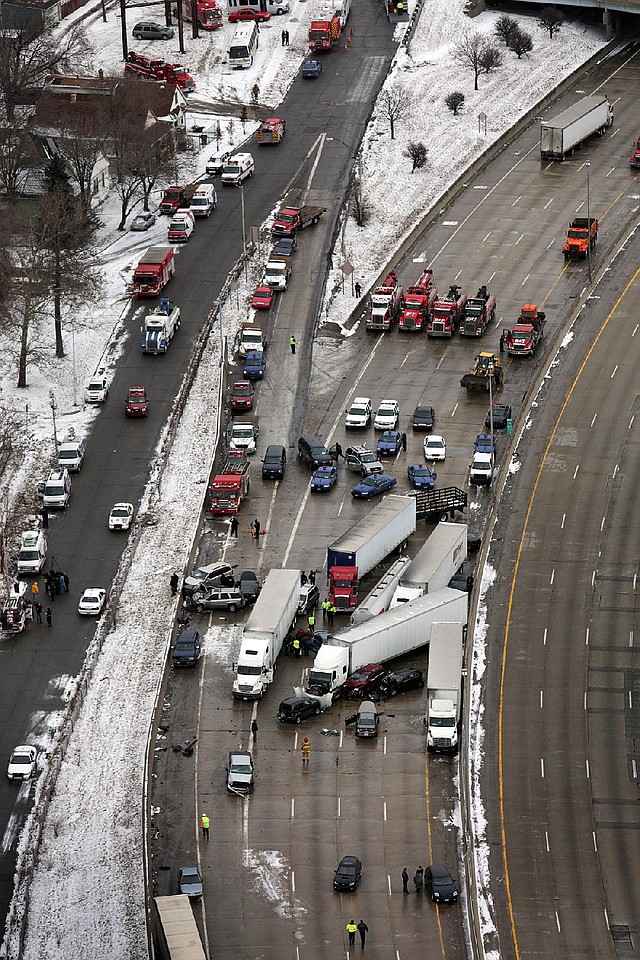Detroit squalls spur I-75 pileup
At least 3 dead, 13 hurt as sudden snow sends vehicles skidding
Vehicles sit in a tangle after a whiteout Thursday caused a mile long series of crashes along Interstate 75 on the southwest side of Detroit.
Friday, February 1, 2013
DETROIT — Blinding snow squalls, high winds and a slick highway led to a mile-long series of crashes in Detroit that left at least three people dead Thursday, including a 7-year-old boy and 9-year-old girl.
Michigan State Police Lt. Michael Shaw said visibility was extremely poor when the mass of crashes happened on Interstate 75 on the southwest side of the city. At least 13 people were rushed to hospitals, and others were treated at the scene, Shaw said.
Sport utility vehicles with smashed front ends and cars with doors hanging open sat scattered across the debris-littered highway, some crunched against jackknifed tractor-trailers and tankers.Rescue crews went vehicle to vehicle in the search for survivors and to provide aid. About 30 vehicles were involved in the morning accident.
Shaw said the two children killed are believed to be siblings, and their parents were hurt in the wreck. He said the boy died at the scene, and the girl died at a hospital.
Shaw said the family is believed to be from Windsor, Ontario, across the Detroit River in Canada. None of the victims’ names has been released.
A similar pileup west of Indianapolis involving about 35 vehicles closed Interstate 70 in both directions. Authorities said about 10 people were injured, and the interstate was expected to be closed for several hours.
In Detroit, the pileups were along a stretch of busy freeway that cuts through a heavily industrialized part of the city and nearby communities. Semitrailers and tankers dominate the interstate, some hauling loads and liquids to a nearby refinery and steel companies.
Motorists and passengers who were able to climb out of their vehicles huddled together on the side of the road, some visibly distraught, others looking dazed. A man and woman hugged under the gray, cloud-filled skies, a pair of suitcases next to them and a bumper on the ground behind.
Conditions went from “clear to total whiteout in a matter of seconds,” Shaw said. “All of a sudden, they couldn’t see anymore.”
The bad weather also is being blamed for at least two other pileups in Michigan. U.S. 23 in Mundy Township near Flint was closed for several hours after 33 vehicles crashed during a sudden snow squall. In southwest Michigan, eight tractor-trailers and six cars crashed on I-94, closing the westbound lanes to traffic at Paw Paw for several hours.
In Detroit, scores of vehicles that escaped damage were trapped on the freeway behind the accident scene for hours. Both directions of I-75were reopened by midafternoon.
Shaw said many people had to be pulled from their vehicles. Numerous fire engines and ambulances were at the scene.
The crash happened as snow and strong blustery winds reduced visibility across southeastern Michigan, said Bryan Tilley, a meteorologist with the National Weather Service in Oakland County’s White Lake Township.
“There was a pattern of snow showers moving through the area in the midmorning hours,” Tilley said. Nearby Detroit Metropolitan Airport had west winds at 20 mph, with gusts to 33 mph around the time of the crash.
The temperature of 24 degrees was about 30 degrees lower than a day before.
The crash happened near an elevated stretch of expressway where the road surface can cool quickly and make driving hazardous, Tilley said.
Meanwhile, three people died because of a storm system that marched across the U.S. - tornadoes killed one each in Tennessee and Georgia, while flood waters killed a third in Maryland.
Tens of thousands were without power at the storm’s peak as a cold front sent what had been unseasonably high temperatures plummeting to near-freezing depths. Dangerous wind blanketed the nation’s midsection, with subzero temperatures and wind chills recorded in the Dakotas.
Near the nation’s capital, at least one motorist had to be rescued because of flash floods. In New England, powerful winds were the main problem as gusts topping 60 mph in some areas caused widespread power failures.
Information for this article was contributed by Mike Householder, David N. Goodman, Jeff Karoub, David Aguilar, Johnny Clark, Phillip Lucas and Matthew Barakat of The Associated Press.
Front Section, Pages 4 on 02/01/2013
